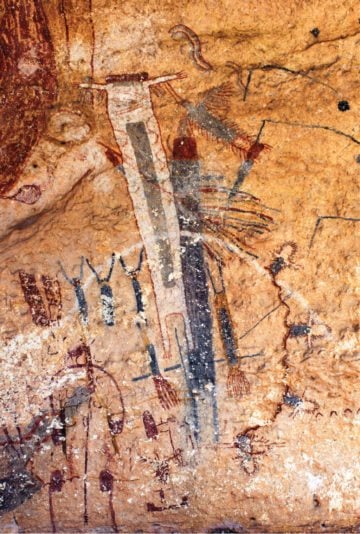If These Walls Could Talk
 Chester Leeds
Chester Leeds
The White Shaman mural is painted on the east wall of a southwest-facing shelter, and faces due west. The positioning of figures within the mural suggests alignment with sun and shadow as observed on the solstices.
September 12, 2012, was a long day, but a good one. For Carolyn Boyd it started with a 30-minute drive from her home in Comstock to a 265-acre preserve, where she convened with fellow archaeologists Mark Willis and Amanda Castaneda and left the road behind. From there it was a half-hour walk on a well-worn trail traversing cactus-strewn stone. The ladder they carried made for awkward hiking, but the cool fall morning helped compensate. By 8:30 a.m. they had climbed down from the scrubby plateau and arrived at a shallow, mouth-shaped indentation near the top of a rough cliff overlooking the Pecos River. Just downstream, occasional cars and semis hummed across the 1,310-foot bridge that carries U.S. Highway 90 over the river, almost 300 feet below. A little more than a mile downstream, the Pecos slipped quietly into the Rio Grande.
The mouth-shaped indentation was well known, the site of an elaborate expanse of prehistoric painted rock art known as the White Shaman mural, after its spectral central figure. Boyd had been to the shelter maybe a hundred times, but this was the first time she had come equipped with a $500 Dino-Lite digital microscope.
The White Shaman mural is painted in four colors — red, black, yellow and white, often overlapping or interwoven — and Boyd wanted to know in which order the paints had been applied. The Dino-Lite, more commonly deployed in medical and industrial applications, was Willis’ idea. Using the handheld microphone-size capsule, Boyd could examine the margins between pigments at the microscopic level, and simultaneously take high-resolution photographs to examine back in the lab.
As Boyd moved methodically across the wall, Willis — watching the images on a laptop connected to the Dino-Lite via USB cable — called out what the screen was showing him: “red over black; red over black; yellow over red; yellow over black; white over yellow.”
Read more:
https://www.texasobserver.org/if-these-walls-could-talk/
Cross-posted in the Anthropology Group.
